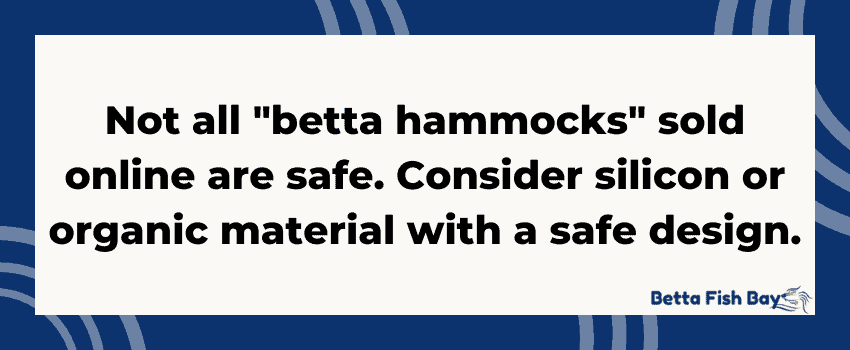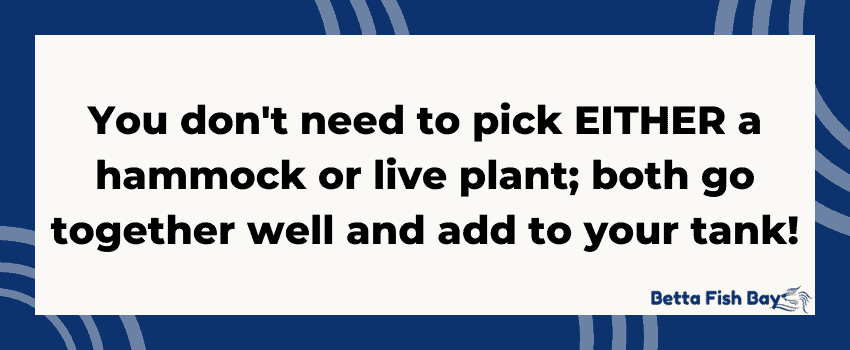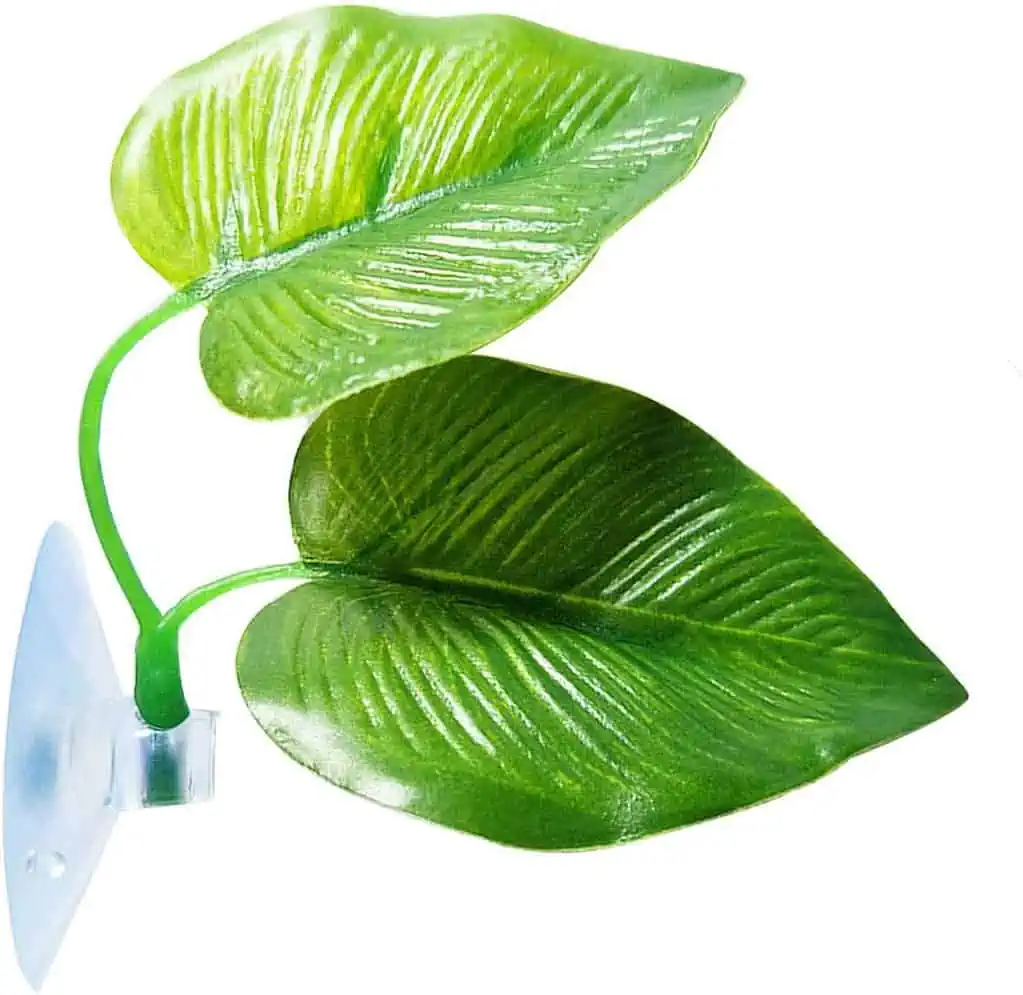Betta hammocks are a popular aquarium decoration and for good reasons.
But many people don’t know why they’re so good or even what one is!
There are several ways your betta will benefit from a betta fish hammock. Examples include reduced stress levels, better access to oxygen during rest, and a more natural environment. This decoration also can potentially improve your tank’s overall aesthetic.

Table of Contents
Betta Hammock Basics
What is a betta hammock?
A betta fish hammock is a piece of “furniture” to include in your betta tank.
Most betta hammocks take the form of a large leaf with strong suction cups attached. The leaf may be real or artificial.
The leaf rests near the water’s surface. This allows your betta to sleep or lounge where they can easily come up for oxygen during rest.
Betta fish rely on the gas exchange due to their labyrinth organ. This makes a betta fish hammock essential.
Here are some benefits associated with having a hammock in your betta fish tank:
- Gives your betta a safe and convenient resting spot
- Reduces stress levels in your betta
- Mimics the natural environments of betta fish, where plants are abundant
Types of Betta Hammocks
Leaf Hammocks
A leaf hammock can take one of two forms:
- An artificial leaf with suction cups attached
- A plant with real leaves reaching toward the water’s surface
This is the most popular style of betta hammock. It’s simple and resembles Bettas’ natural environment.
Floating Logs
Floating logs are another great option.
This type of betta hammock is usually made from artificial materials and resembles a log. Most of them feature simple suction cups to let them “float.”
In this case, your betta will have a hidey-hole to enjoy while they rest.
This is especially beneficial for more aggressive betta varieties. The available hiding space will reduce their stress levels.
Floating Plants
In some cases, floating plants can double as a basic betta hammock.
Betta fish originate from Southeast Asia, particularly areas in Thailand, Malaysia, and Indonesia. This means they’re used to living in waters populated with plants.
Sometimes they use the plants as “hammocks” for rest.
As long as you don’t go overboard with floating plants, they can improve the feel and appearance of your tank. Here are some great options to consider:
- Water sprite
- Amazon frogbit
- Dwarf water lettuce
- Catappa leaves
Using real floating plants also reduces ammonia levels in your tank. This is essential because ammonia is toxic to bettas, causing various health issues.
Material and Design

Betta owners must consider the material and design of a betta fish hammock before buying it. Here’s some basic information on what to look for.
Materials Used for Betta Hammocks
There are three common betta hammock material types available:
- Silicone: Silicone hammocks are a solid option. This material is generally considered safe for use in aquariums. But it’s still a good idea to ensure the product is marketed as “aquarium-safe.”
- Plastic: If possible, avoid placing a plastic hammock in your betta tank. Plastic decorations may have sharp edges, damaging your betta’s gorgeous fins. Also, some plastics have high levels of toxic chemicals which can leach into the water and harm your betta.
- Organic materials: Opting for organic materials is ideal. They are natural and less harmful to your betta. Examples of organic materials include real plants and silk. If you choose to include real aquarium plants, avoid plants toxic to bettas!
Design Considerations
There are a few different factors to consider when shopping for a quality betta fish hammock:
- Safety: Betta hammocks are meant to be a safe space for your betta to rest. This makes it crucial to ensure the hammock’s design guarantees its safety. Ensure the hammock you choose has smooth edges and is made from non-toxic materials. Learn more about what to look for in quality betta decorations in our Best Decor For Betta Fish guide.
- Aesthetics: For many betta owners, an aquarium is more than a place to house their fish. It’s also a visually appealing component of their home. Look for natural-looking hammock options, such as floating plants or suction cup leaves. Also, choose a hammock matching with already-existing aquarium decor.
- Durability: Betta hammocks are meant to be a comfortable space for your betta over the long term. This makes it essential to choose hammocks that will stand the test of time. Ensure the hammock you choose is made from quality materials, such as silicone. This will make it resistant to wear and tear.
Installation and Placement
Proper installation and placement are essential. They ensure your betta fish gets the most out of their hammock.
Proper Installation
The method of installation will vary depending on the type of hammock you choose.
Attaching Suction Cups
If you choose a suction cup-style of hammock, follow these steps for installation:
- Open the box or container holding the betta hammock.
- Clean the hammock, if desired, using soap and warm water.
- Attach the hammock’s suction cup(s) to the inside of the tank.
Setup for suction cup decorations is relatively straightforward. This makes them a favorite option among betta owners.
Securing Floating Logs
Floating logs are aquarium decorations designed to float near the top of the tank. Most floating logs bought for this purpose are free-floating.
This means they float around the tank.
Floating logs are a bit more complicated to secure than suction cup hammocks. There are a couple of options you might want to consider:
- Buying a separate suction cup and attaching it to the floating log
- Buying fishline or another string type, to fasten one end around the log and the other end to an anchoring object
Positioning Floating Plants
If you choose to use floating plants as a natural betta hammock, keep the following factors in mind:
- The plants need to be kept away from the tank filter.
- There needs to be extra space left near the water’s surface.
- Floating plants need sufficient lighting.
Consider one of the methods below to keep your floating aquarium plants in one place.
- Fishing Line Plant Border: You’ll need a fishing line and some suction cups for this method. Place the suction cups around the part of the tank where you want the plants. Snake some fishing line through the suction cups’ holes, then secure it to the plants.
- Floating Plant Ring: This method uses an air hose to create a ring. The ring will keep the floating plants in place.
- To create the ring, measure 2″ inches of air hose tubing.
- Use an air pipe connector bow to connect both ends of the tubing, creating a circular shape.
- Now, position the floating plants inside it to secure them.
Note: This method also works using straws or the center of a plastic bottle as the ring.
Optimal Placement

When placing your betta fish hammock, ensure its location meets these criteria:
- Near the water surface: Secure the hammock somewhere near the water’s surface. This is crucial because bettas must come up to the surface for oxygen. Placing the hammock near the surface makes this easier for them to do when resting.
- Close to hiding spots: Bettas are a private and aggressive fish species. This means they need plenty of hiding places. To ensure your betta’s comfort, place its hammock near one of its hiding spots. Alternatively, consider buying a hammock featuring its own hiding place. This is a common feature in floating logs.
- Away from high-flow areas: Bettas’ natural habitats include the sluggish waters of Thailand and nearby Southeastern countries. For this reason, they prefer environments with still or low-flow waters. Place your betta fish hammock in a calm spot away from the aquarium filter.
Safety and Risks
Before buying a betta hammock, learn the risks of this essential aquarium accessory.
Identifying Potential Hazards
The three most problematic things to watch for are the following:
- Sharp edges: Plastic hammocks, in particular, are prone to having sharp edges. These edges can damage your betta’s fins, which can later lead to infection.
- Entrapment risks: Some hammock designs may pose a risk of entrapment. Opt for hammocks with more open designs, and be sure to look at customer reviews before buying a product.
- Toxic materials: Many aquarium decorations on the market today pose toxicity risks. Avoid hammocks made from potentially dangerous materials, such as low-quality plastics. Also, avoid those colored using toxic paints, as the paint can leach into the water.
Mitigating Risks
The best ways to reduce these risks are regular inspection and high-quality products.
We recommend checking on the status of your aquarium frequently. Look for any issues directly involving the hammock, such as peeling paint or sharp edges.
Also, check the water quality often to ensure toxin levels are low.
When it comes to finding high-quality products, consider these factors:
- Material: Opt for hammocks made from high-quality, non-toxic materials. Silicone and silk are two great options.
- Features: Determine what features you want in your betta hammock. For example, you might want a leaf hammock featuring wide leaves for your betta to sprawl on. Or, you might want a hammock with a built-in hiding spot for your betta.
- Reviews: Customer reviews are a good way to determine whether a product is right for you. See what others have said about the hammock’s overall quality, features, and ease of use. Also, ensure no customers have complained about peeling paint or toxins leaching into the water.
- Brand reputation: Research brands before buying anything. Choosing a reputable brand helps ensure you’re getting good quality products. See how different brands rank regarding product quality, customer support, shipping, and other key factors.
Alternatives to Betta Hammocks

Not convinced you need or want a betta hammock for your tank? Fortunately, there are other options to consider.
Live Plants
Betta fish love plant-rich environments. Including various aquarium plants in your tank is a great way to provide natural resting or sleeping spots.
Here are just a few plants we recommend:
- Anubias
- Java fern
- Amazon sword
Plant Decorations
Likewise, artificial plants can serve the same purpose as a betta hammock.
We recommend opting for those made of silk, as silk poses fewer health risks than plastic, for example.
This being said: plastic leaves may be acceptable if you ensure they have no sharp edges. Also, check whether toxic paints or other substances were used while making the product.
Other Resting Spots
Here are some options to consider:
- Ceramic caves
- PVC pipes
- Driftwood
Really, any high-quality tank decoration featuring privacy and access to oxygen should work. Ensure you place the decoration(s) in a quiet spot with still waters, where your betta won’t be disturbed.
DIY Betta Hammocks
Creating your own betta hammock is a rewarding creative endeavor. Here’s a quick design idea for you:
Creating a Homemade Betta Hammock
Materials
- Folding cutting board
- Suction cups
- Silicone
Instructions
- With a folding cutting board, cut into a leaf shape. Ensure the edges are smooth.
- Scour the leaf’s center, then put some cuts in the stem. Fold it at the tips, as the silicone will hold better this way.
- Fill the back of the suction cup with silicone, then press the stem in.
- Let it sit for 48 hours.
Safety Considerations for DIY Hammocks
While creating your DIY betta hammock, keep these two things in mind:
- Use only non-toxic materials. To be safe, opt for products labeled as being safe for aquariums.
- Ensure the edges of the product are smooth. This will protect your betta from damaging its fins.
Live Plants and Decoration

A betta hammock is a great addition to your aquarium setup. Combine it with complementary decorations and live plants for a natural aesthetic you and your betta will love.
Integrating Betta Hammocks With Live Plants
Your betta tank should contain various functional and attractive elements. Live plants are both:
- They add a natural aesthetic to the tank.
- They leech essential tannins into the water.
- They provide a place of rest and privacy for your betta.
- They oxygenate the water, which is crucial for bettas.
See our list of beautiful flowering aquarium plants to consider throwing into the mix.
Additional Decorations
There are all kinds of decorations to include, both natural and artificial.
For example, rocks and driftwood are two natural decorations to consider. They’ll create an enticing aesthetic and make your betta’s tank feel more like home.
Themed artificial decorations are another popular option. There are all kinds of themed decorations available.
Common ones include pirates and castles, but the possibilities are endless.
Once again, ensure you only purchase decorations made from high-quality, non-toxic materials.
Give Your Betta Fish the Gift of Comfort
Your betta will enjoy having a dedicated spot to rest or sleep.
The information in this article is a great place to start. But we recommend browsing BettaFishBay.com for more useful information on betta care.
If you learned something from this article, share it with your betta friends on social media!



